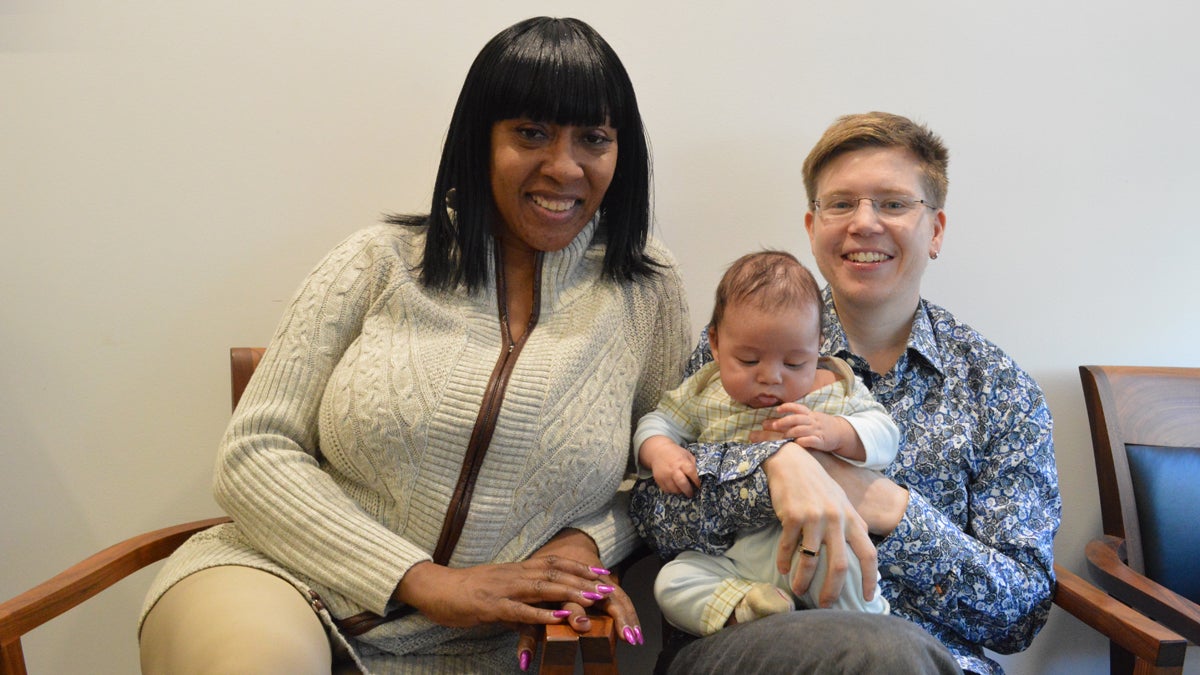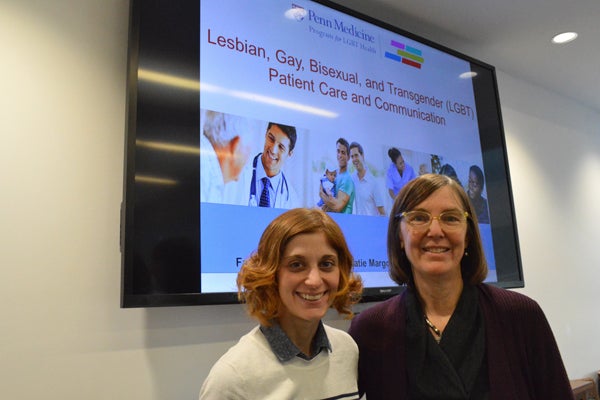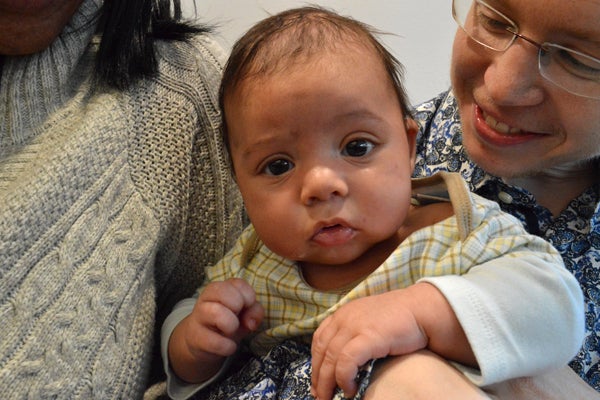Teaching medical professionals how to talk to transgender patients
Listen
Junior Brainard (right)
Imagine that you’re a receptionist at a medical clinic. You call the name of the next patient — Fred Jones — and a woman stands up. You’re confused and not entirely sure what to say.
Now imagine you’re on the other side of that equation. You’re a transgender patient seeing a doctor for a routine physical. But before you can even see the doctor, your gender identity is called into question.
“Often, one of the barriers that trans people experience is the first person they encounter at the clinic,” explains Jamison Green, the president of the World Professional Association of Transgender Health.
That’s why health clinics are training their staff on better ways of talking to and about transgender patients. Most physicians learn these things in medical school, but for those on the front lines, such as receptionists and office staff, they may have never had training like that.
Katie Margo, a physician and associate professor of family medicine at the University of Pennsylvania, has the non-physician staff of Penn Family Care gathered in a conference room. They’re sitting toward the back, like students in a lecture hall.
Margo is standing in front, next to a screen with a PowerPoint titled “Lesbian, Gay, Bisexual, and Transgender Patient Care and Communication”.
 Dr. Katie Margo (right) and Dr. Allison Myers, lead a training for their staff on how to talk to transgender patients. (Paige Pfleger/WHYY)
Dr. Katie Margo (right) and Dr. Allison Myers, lead a training for their staff on how to talk to transgender patients. (Paige Pfleger/WHYY)
Today, she’ll be training them specifically on care of transgender patients, which is why she invited along Junior Brainard, a transgender man, and his partner, Tina Montgomery.
“Sometimes you’re going to call somebody’s name that says Fred so and so, and up will pop a woman,” Margo says to the staff. “And it’s confusing to you. Has anybody had that happen?”
Some of her staffers, clad in jewel-toned scrubs, nod.
“Yeah? So, what do you do?”
Tina Montgomery chimes in, suggesting that instead of using first names, the staff should just say the first initial and the last name of the patient.
“And then when they stand up, it’s not good to call them out in front of everyone. To say ‘You are Fred Jones?’ didn’t help,” she says, pausing. “Try not to stare when they get up.”
Margo knows how confusing these situations can be. She wasn’t always an expert in LGBT issues.
Back in the early 2000s, a transgender man came to Margo’s clinic. He wanted her to prescribe him hormones. It’s something she does routinely today, but at the time, she didn’t know anything about it.
“He said, ‘You really need to go to this conference, you need to look at this stuff online,’ and I did,” she said. “And it was incredibly helpful.”
The education she sought out is the kind of education she wants everyone she works with to have. That’s why she’s holding the transgender training, and why she teaches a class to Penn medical students about the subject.
Margo explains that in many East Coast cities, there’s a health center that specializes in LGBT care. But, as of recently, these centers have more patients than they can take care of.
“There’s been a growing trend of transgender people being able to connect with other transgender people, realize they’re not alone, and feel empowered to ask for services that everyone else receives,” Jamison Green from WPATH explains.
The uptick in demand could be from a confluence of factors, including more-inclusive insurance plans, growing acceptance of the transgender community, and the cultural prominence that transgender people have gained over the last few years. This growing demand can be seen around the country.
And in Philadelphia, patients who can’t be seen at the Mazzoni Center, a prominent LGBT health center, have been turning to Margo, whose practice is being marketed toward the LGBT community.
“They seek out a number of things,” she explains. “First and foremost is equal and compassionate care, sensitive to their particular situation.”
That equal and compassionate care can be hard to get for someone who is transgender. A national survey found that about half of the 6,000 transgender and gender nonconforming people surveyed reported avoiding medical attention when they’re sick, out of fear of discrimination.
Junior Brainard and his partner Tina Montgomery know about this firsthand, which is part of the reason they’re here today.
“We had a very negative experience,” Brainard said to the room full of staffers. “This was about five years ago at the Penn Fertility [Care] clinic that basically ended in — they refused to work with us and told us we’d never conceive a biological child.”
The couple’s plan was for Brainard to carry and give birth to the baby.
Though uncommon, their plan was possible, as evidenced by baby Tony, happily drinking from a bottle on Brainard’s lap.
 Tony, who is 4 months old, on Junior Brainard’s lap. (Paige Pfleger/WHYY)
Tony, who is 4 months old, on Junior Brainard’s lap. (Paige Pfleger/WHYY)
Bad experiences in medical settings are especially problematic for the transgender patient population, Jamison Green explains. The transgender community has high rates of substance abuse, HIV, and mental health issues, including depression, anxiety, and suicide.
“Part of the reason that those disparities have occurred is the stigma and the bias that prevents people from getting the care that they need,” Green says.
Making the doctor’s office safe and welcoming could mean the difference between catching those things early and being too late.
WHYY is your source for fact-based, in-depth journalism and information. As a nonprofit organization, we rely on financial support from readers like you. Please give today.



